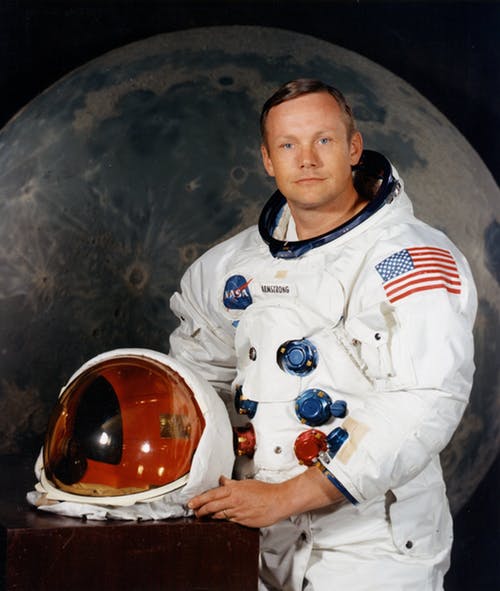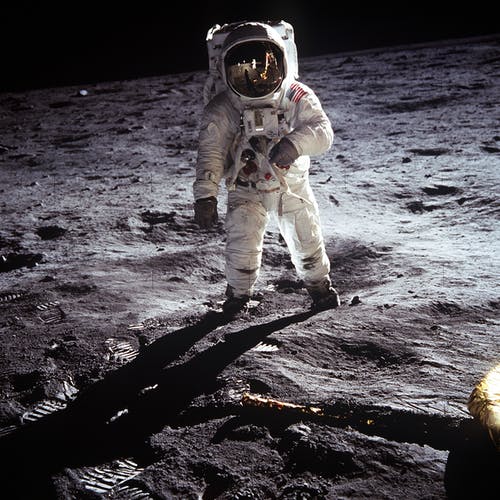“It’s a sultry night in July. You’ve fallen asleep in the armchair. Abruptly, you startle awake, disoriented. The television set is on, but not the sound. You strain to understand what you’re seeing.
“Two ghostly white figures in coveralls and helmets are softly dancing under a pitch- black sky. They make strange little skipping motions, which propel them upward amid barely perceptible clouds of dust. But something is wrong. They take too long to come down. Encumbered as they are, they seem to be flying…a little. You rub your eyes, but the dreamlike tableau persists.
“Of all the events surrounding Apollo 11’s landing on the Moon on July 20, 1969, my most vivid recollection is its unreal quality. Neil Armstrong and Buzz Aldrin shuffled along the grey, dusty moon surface, the Earth looming large in their sky. While Michael Collins now the moon’s own moon orbited above them in lonely vigil.”
These words were spoken by Carl Sagan, American astronomer, cosmologist, astrophysicist, astrobiologist and author; but whom is probably most famous for his 13-part television series “Cosmos.”
On July 20, 2019 it’ll be 50 years since that initial moon landing. Though the Apollo missions lasted till Dec. 7, 1972, the one that is remembered most is that initial voyage across the 238,900 miles that separate the Earth from its only naturally occurring satellite, the Moon.
As Neil Armstrong took his first step into the regolith of the Moon, Walter Cronkite removed his glasses in awe and uttered, on-air, “Man on the moon!…Oh, boy…Whew, boy!”
He had said later that he’d hoped to say something more profound, but that it was really all that could be uttered. I don’t really think we can blame him.
Millions of people watched on July 16, 1969 as Apollo 11 launched from the Kennedy Space Center, helped by a Saturn V rocket. The trip took 4 days, 6 hours, and 45 minutes. Four and a quarter days in an aluminum ship set out across a gulf, void of breathable air with temperatures that can vary to horrifying extremes.
As Armstrong stepped from the Eagle (the name for the lunar module) into the Sea of Tranquility, the name given for the sea of flat basalt below the Moon’s highlands, he uttered those famous words, “That’s one small step for man, one giant leap for mankind.”
Though, Armstrong, a Wapakoneta, Ohio native, who died August 25, 2012 in Cincinnati, Ohio would later claim that he had actually said, “That’s one small step for a man…” referring to the single step he was taking that day.
Apollo 11 would effectively end the Space Race, a super-power competition between the Soviet Union’s cosmonauts and the United States astronauts, which started back in ‘55 when the Soviets announced they’d release Sputnik 1, the first artificial satellite to orbit Earth. It launched on Oct. 4, 1957.

Though Armstrong was the first person to step foot on the moon, he was not the first human being to journey out into space. That honor going to Soviet pilot and cosmonaut Yuri Gagarin, whose shuttle, the Vostok 1 spent 108 minutes above the Earth’s atmosphere in a single orbit, before Gargarin parachuted down at 23,000 ft above the Earth’s surface.
“For one priceless moment in the whole history of man, all the people on this Earth are truly one.” said then-President Nixon in a phone call to Armstrong and Aldrin as they were on the moon.
“We choose to go to the moon in this decade and do the other things, not because they are easy, but because they are hard.” said Kennedy, who jump started the goal by declaring that, “This nation should commit itself to achieving the goal, before the decade is out, of landing a man on the moon and returning him safely to Earth.”
In ‘75, in the heat of the Cold War, the Soviets and the U.S. partook in The Apollo and Soyuz Test Project. The goal being to bring a ceremonial end to the Space Race with a joint mission between the world’s two sole space explorers, at that given time.
“It has been said that astronomy is a humbling and character-building experience.” said Sagan in his now infamous Pale Blue Dot speech from “Cosmos.”
“There is perhaps no better demonstration of the folly of human conceits than this distant image of our tiny world. To me, it underscores our responsibility to deal more kindly with one another, and to preserve and cherish the pale blue dot, the only home we’ve ever known.”
CNN’s film department released a documentary chronicling the entire event, which was released back in January at Sundance and went wide in March. Though, if you missed it, do not fret, as it’s currently playing at the IMAX theatre at Wright-Patterson Air Force Base, and will be playing the 20th and 21st at the Plaza theater in Miamisburg.
“Yes, as Armstrong said as he first alighted, this was a historic step for the human species,” said Sagan. “But if you turned off the byplay between Mission Control and the Sea of Tranquility, with its deliberately mundane and routine chatter, and stared into that black-and-white television monitor, you could glimpse that we humans had entered the realm of myth and legend.”
Twelve men have walked on the moon’s dusty, grey surface since 1969. None have since 1972. None have ventured further into the black, empty cosmic infinity beyond.
Richard Foltz
Managing Editor


